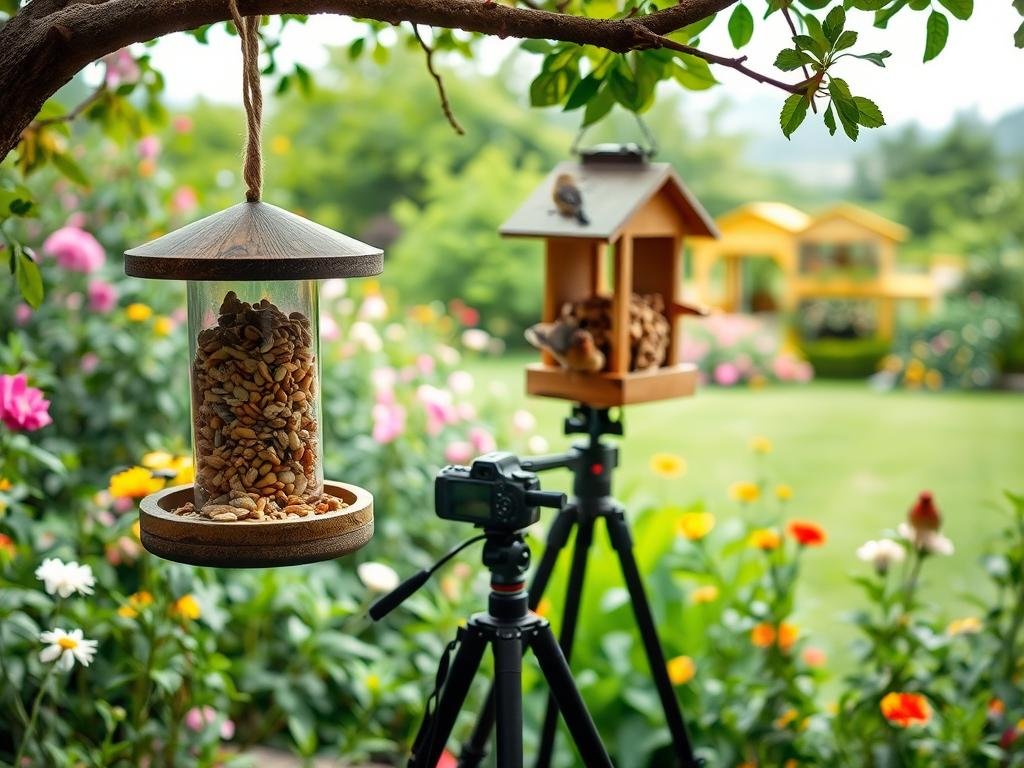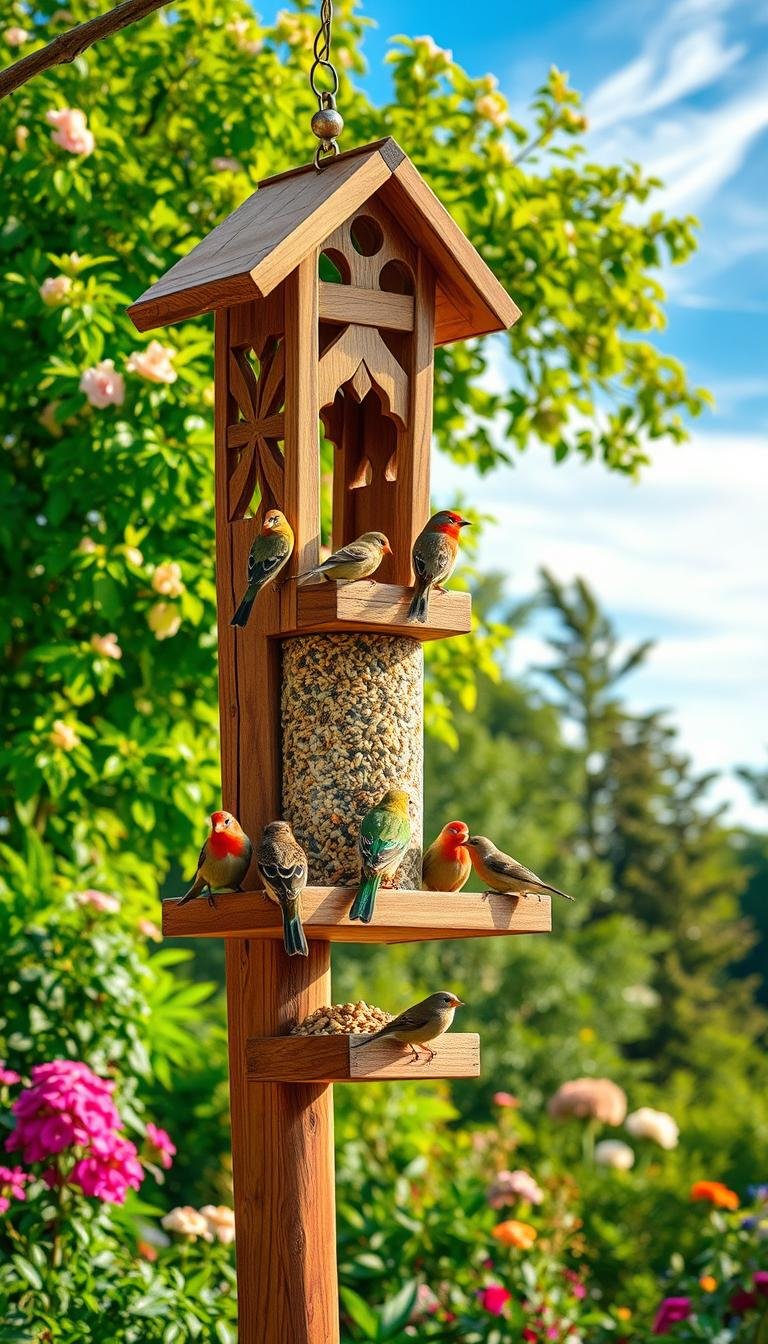Modern technology has transformed birdwatching into an engaging and accessible hobby. With a smart bird feeder and camera, you can observe your feathered friends in real-time, even from the comfort of your home. These setups offer 24/7 monitoring, allowing you to capture rare behaviors and learn more about different species.
Choosing the right equipment is essential. Options range from wireless IP cameras like Reolink and Arlo to DIY setups using smartphones. Camera resolution, such as HD or 4K, and frame rates above 60fps ensure clear, detailed footage. Proper feeder placement and seasonal food choices also play a key role in attracting birds and enhancing your experience.
Advanced features like AI-powered species recognition add a new layer of excitement to birdwatching. Whether you’re a beginner or an enthusiast, these tools make it easy to create a thriving sanctuary in your backyard. Explore more tips and tools at Your Bird Buddy to get started.
Key Takeaways
- Smart feeder-camera setups provide 24/7 monitoring and educational insights.
- Choose cameras with HD or 4K resolution and high frame rates for clarity.
- Proper feeder placement and seasonal food attract more birds.
- AI features like species recognition enhance the birdwatching experience.
- Cost-effective options include DIY setups and affordable wireless cameras.
Essential Equipment for Your Bird Feeder Camera Setup
The right equipment can transform your backyard into a birdwatching haven. From the feeder to the camera, each component plays a vital role in creating an inviting space for feathered visitors.

- 【Advanced AI Identify Over 10000+ Birds】Through AI Identify, ANMESC smart bird feeder with camera can recognize over 100…
- 【Instant Notification of Bird Arrivals】ANMESC bird cameras can automatically capture upcoming birds (such as crows, card…
- 【Specially designed for observing and feeding birds】ANMESC motion activated bird camera feeder, equipped with a 120 ° wi…
The bird feeder list above has brought great joy to our family. And we are sure you will love it as well!
Choosing the Right Bird Feeder
Selecting the perfect bird feeder depends on the species you want to attract. Tube feeders are ideal for small birds like finches, while platform feeders accommodate larger species. Materials matter too—acrylic is durable, metal resists squirrels, and recycled plastic is eco-friendly.
Consider feeder capacity and refill frequency. For example, the Netvue Birdfy holds 720ML of seed, reducing the need for constant refills. Placement is also crucial. Position feeders near natural perches but away from predators to ensure safety.
Must-Have Camera Features for Birdwatching
A high-quality camera is essential for capturing clear, detailed footage. Look for features like 1080p resolution and 60fps frame rates to ensure sharp images of fast-moving birds. The Blink Mini, for instance, records in 1080p with motion alerts and night vision.
Weather resistance and power options are also important. Solar-powered cameras, like the WiFi BirdCam Pro, offer eco-friendly solutions, while battery-powered models provide flexibility. Avoid digital zoom to maintain image quality and ensure the camera has a minimum focus distance of 3 inches for close-up shots.
For more advanced setups, explore options like the WiFi BirdCam Pro, which combines HD video with AI bird identification for an enhanced experience.
Types of Cameras for Capturing Birds at Your Feeder
Different cameras offer unique features for observing birds at your feeder. Whether you’re looking for advanced AI capabilities or budget-friendly options, there’s a device to suit your needs. Here’s a breakdown of the most popular choices.
Smart Bird Feeder Cameras (All-in-One Solutions)
Smart bird feeder cameras combine convenience and advanced technology. Models like the Birdfy AI recognize over 10,000 species using the AMNH database. These devices often include 1080p wide-angle cameras with color night vision, ensuring high-quality footage day and night.
Many smart feeders come with companion apps for filtering, saving, and sharing sightings. For example, the Netvue Birdfy app allows users to join a community of bird enthusiasts. Solar charging options and weatherproof designs make these devices durable and eco-friendly.

Action Cameras Like GoPro for High-Quality Video
Action cameras, such as the GoPro Hero 12, are ideal for capturing fast-moving birds. With HyperSmooth 6.0 stabilization, these devices deliver smooth, detailed video even in challenging conditions. Mounting options like suction cups and flexible grips make them versatile for various setups.
However, action cameras may require additional accessories for long-term use. They’re best suited for enthusiasts who prioritize portability and video quality over continuous monitoring.
Budget-Friendly Options: Trail and Dashboard Cameras
Trail cameras, like the Reolink Argus Eco, offer an affordable way to monitor your feeder. These devices feature solar power and 1080p resolution, making them ideal for outdoor use. Night vision capabilities ensure round-the-clock monitoring.
Dashboard cameras are another budget-friendly choice, though they often have shorter battery life and lower image quality compared to specialized devices. They’re a good option for casual birdwatchers or those testing the waters.
Security Cameras for Permanent Setups
For those seeking a permanent solution, security cameras like the Dahua HDW5241H-S2 are a solid choice. These devices offer continuous operation, 5x optical zoom, and DVR integration for seamless recording. Their robust build and weatherproof ratings ensure durability in all conditions.
Security cameras are ideal for users who want a reliable, long-term setup. Explore more tips and tools at Your Bird Buddy to enhance your birdwatching experience.
Step-by-Step Guide to Set Up a Bird Feeder And Camera
A well-planned setup ensures you never miss a moment with your feathered visitors. Follow these steps to create a seamless birdwatching experience in your home.
Selecting the Perfect Spot for Your Feeder
Choosing the right spot is crucial for attracting birds and ensuring their safety. Position the feeder 3-10 feet from windows to prevent collisions. Place it near natural cover, like shrubs or trees, to provide shelter from predators.
Optimal placement includes a north-facing area with a downward tilt to minimize glare. This ensures clear footage and a comfortable environment for birds to visit.

Installing the Camera and Connecting to Wi-Fi
Once the feeder is in place, it’s time to install the camera. Elevate it slightly above the feeder for a clear view of all activity. Ensure the camera has a minimum focus distance of 3 inches for sharp close-ups.
Connect the device to a 2.4GHz Wi-Fi network for stable streaming. Use apps like Blink or JJ Home to pair the camera with your phone and enable notifications.
For night-time monitoring, use black tape to eliminate LED reflections and ensure clear footage. Test the setup with bird decoys or seed piles to confirm optimal performance.
Conclusion
Creating a sanctuary for your feathered friends in your backyard is both rewarding and educational. Automated feeder-camera systems offer 24/7 monitoring, allowing you to observe birds in their natural habitat. Starting with budget-friendly options like Blink or Wyze cameras is a great way to dip your toes into this hobby before upgrading to premium systems like Birdfy AI.
These setups provide an excellent opportunity for families to learn about wildlife together. Enhance your experience with accessories like heated bird baths or squirrel guards. Regular maintenance, such as cleaning and battery checks, ensures your system runs smoothly year-round.
For a broader view of group behaviors, consider adding a secondary wide-angle camera. Share your discoveries on social media using #SmartBirding to connect with fellow enthusiasts. Explore more tips and tools at Wasserstein Home to elevate your birdwatching experience.




0 Comments